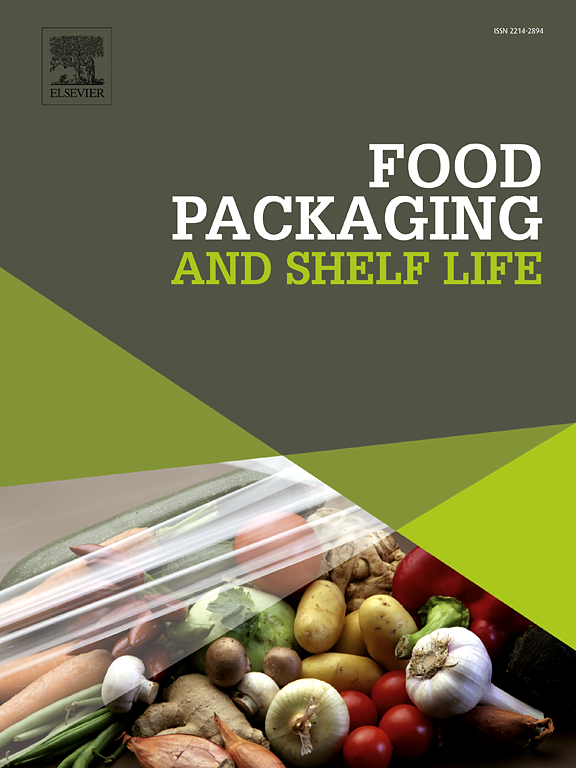手持式微流体吹丝法原位制备纳他霉素和反式肉桂酸负载聚己内酯/乙基纤维素芒果纳米纤维的保鲜研究
IF 8.5
1区 农林科学
Q1 FOOD SCIENCE & TECHNOLOGY
引用次数: 0
摘要
芒果营养丰富,但易腐烂。用纳米纤维对水果表面进行原位包装是一项很有前途的水果保鲜研究。采用手持式微流体吹丝(MBS)技术在芒果表面原位制备了负载纳他霉素(Nata)和反式肉桂酸(tCA)的聚己内酯/乙基纤维素(PCL/EC/Nt-p)纳米纤维膜,以提高芒果的贮藏品质。结果表明,PCL/EC/Nt-p纳米纤维的平均直径为321.82 ± 10.06 nm,形貌光滑均匀。较低的杨氏模量使芒果表面的纳米纤维膜在食用前容易以较小的力剥离。此外,PCL/EC/Nt-p纳米纤维膜具有理想的疏水性和水蒸气透过率,可以在高湿环境下保护其结构完整性,并减少处理后芒果的水分损失。贮藏结果表明,经PCL/EC/Nt-p纳米纤维膜处理的芒果病变直径最小,腐烂指数比未经处理的芒果低20 %。另外,PCL/EC/Nt-p纳米纤维膜处理芒果9 d后,其SOD、CAT、POD和APX抗氧化酶活性的下降被延缓,证实了膜具有增强抗氧化能力和减缓代谢过程的能力。本研究为水果原位保鲜包装的研究、微流吹纺丝和手持式纺丝机的广泛应用提供了有价值的见解。本文章由计算机程序翻译,如有差异,请以英文原文为准。
In situ preparation of natamycin and trans-cinnamic acid loaded polycaprolactone/ethyl cellulose nanofibers on mangoes via handheld microfluidic-blow-spinning for freshness preservation
Mangoes are nutritious but perishable fruits. The in situ packaging of fruit surfaces with nanofibers is a promising study for fruit preservation. Polycaprolactone/ethyl cellulose (PCL/EC) nanofibrous films loaded with natamycin (Nata) and trans-cinnamic acid (tCA) (PCL/EC/Nt-p) were prepared in situ on the surface of mangoes using handheld microfluidic-blow-spinning (MBS) to enhance mango storage quality. The results show that the PCL/EC/Nt-p nanofibers had an average diameter of 321.82 ± 10.06 nm and displayed a smooth and uniform morphology. The lower Young’s modulus facilitated easy peeling of the nanofibrous films from the mangoes surface with less force before consumption. In addition, the PCL/EC/Nt-p nanofibrous film had an ideal hydrophobicity and water vapor transmission rate, which protected their structural integrity in high-humidity environments and also reduced water loss from the treated mangoes. Storage results show that the mangoes treated with PCL/EC/Nt-p nanofibrous films exhibited the smallest lesion diameter and a decay index 20 % lower than untreated mango. Moreover, after 9 days of storage, the decrease in SOD, CAT, POD, and APX antioxidant enzyme activities was delayed in the PCL/EC/Nt-p nanofibrous film treated mangoes, confirming the film’s ability to enhance antioxidant capacity and slow down metabolic processes. This study provides valuable insights to facilitate the research on in situ fruit preservation packaging, the widespread adoption of microfluidic-blow-spinning and the handheld spinning machine.
求助全文
通过发布文献求助,成功后即可免费获取论文全文。
去求助
来源期刊

Food Packaging and Shelf Life
Agricultural and Biological Sciences-Food Science
CiteScore
14.00
自引率
8.80%
发文量
214
审稿时长
70 days
期刊介绍:
Food packaging is crucial for preserving food integrity throughout the distribution chain. It safeguards against contamination by physical, chemical, and biological agents, ensuring the safety and quality of processed foods. The evolution of novel food packaging, including modified atmosphere and active packaging, has extended shelf life, enhancing convenience for consumers. Shelf life, the duration a perishable item remains suitable for sale, use, or consumption, is intricately linked with food packaging, emphasizing its role in maintaining product quality and safety.
 求助内容:
求助内容: 应助结果提醒方式:
应助结果提醒方式:


